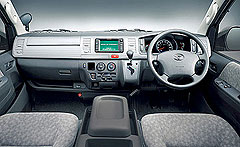Make / Model Search
New models - Toyota - HiaceFirst drive: Toyota’s HiAce - a new vintage vanRefreshed: New styling encloses a bigger, safer HiAce box. Rather than risk the radical, Toyota chose steady evolution for its fifth generation HiAce11 Mar 2005 By JOHN WRIGHT Back in the 1960s Toyota chose ‘HiAce’ as the name for its new light commercial range. The ‘Hi’ represented High Performance, while ‘Ace’ signified a hard worker. Not all that much has changed in nearly half a century and the latest model retains the same essential character. In developing the new HiAce, the term BEST was used – Beneficial, Efficient and economical, Safety and Tough Transport. “Increased passive safety was one of our most important targets,” says HiAce chief engineer Hideyuki Iwata. “We set out to achieve this while maintaining the cargo floor length that HiAce customers require. Achieving that balance meant rethinking the whole crash absorption process and a major effort in advanced computer aided design. "The result was a new chassis structure, with two-layered side members to disperse and absorb crash impact energy. I call this unique Y-frame structure the alligator chassis, but you might prefer crocodile.” And in the event of a frontal impact the brake booster is swivelled away from the brake pedal and steering column. Dual airbags are standard but anti-lock braking is optional. Toyota claims the HiAce is competitive with any rivals on safety, although it has not yet undergone benchmark European NCAP testing. Standard air conditioning probably belongs under B for Beneficial. And Toyota matches its latest rivals by providing a dash-mounted gearchange for both manual and automatic versions. A new wide-bodied Super Long Wheelbase (SWLB) variant has a 3110mm wheelbase to take HiAce into new territory and is expected to bring incremental sales. Utility remains the key theme. The engine has been moved 20mm forward to the benefit of cargo floor length. Door openings are wider and SLWB models have higher sliding door openings. There are more storage areas, especially around the driver’s seat. The standard long wheelbase (LWB) van has six cubic metres of cargo space with a floor length of 2930mm, while the SLWB has 9.8 cubic metres and floor length of 3470mm. Cargo heights and widths are 1335/1635mm and 1545/1730mm respectively. And big gains in fuel efficiency have been achieved thanks to two new engines. The diesel is a 16-valve common-rail turbocharged unit of 2.5-litres capacity, delivering 75kW at 3600rpm and 260Nm of torque from 1600 to 2400rpm in its base form. The diesel engine used in the SLWB van and Commuter bus is equipped with an intercooler which boosts peak power to 80kW at 3600rpm and offers a broader torque spread. Both variants feature electronic engine management and drive-by-wire throttle. The previous diesel engine had eight valves and no turbo. The 2.7-litre dual overhead camshaft, multi-valve petrol engine makes 111kW of power at 4800rpm and 241Nm of torque at 3800rpm.  All models boast improved fuel efficiency. The LWB diesel manual van is said to deliver 20 per cent better fuel economy, averaging 8.1L/100km, while the manual SLWB diesel van and Commuter bus are claimed to be 18.5 per cent more efficient at 8.8. All models boast improved fuel efficiency. The LWB diesel manual van is said to deliver 20 per cent better fuel economy, averaging 8.1L/100km, while the manual SLWB diesel van and Commuter bus are claimed to be 18.5 per cent more efficient at 8.8.The petrol LWB van is rated at 11.6L/100km for both manual and automatic versions. All petrol models feature hardened valves and valve seats to allow for LPG operation. And a factory-backed LPG conversion is on offer for $3500 with the take-up rate expected to be between five and 10 per cent. Transmission choices are five-speed manual and four-speed automatic, which doesn’t look very twenty-first century. European van buyers expect six-speed manuals and five-speed autos. The LWB (2570mm) van is just 55mm longer than the superseded SWB (standard wheelbase) model but provides the same cargo length as the outgoing LWB model. Hideyuki Iwato suggests that the fifth generation will be on sale for about 10 years. All new models Alfa Romeo Alfa Romeo Abarth Abarth Alpine Alpine Alpina Alpina Audi Audi Aston Martin Aston Martin BMW BMW Bentley Bentley Chery Chery Brabham Brabham Chrysler Chrysler Chevrolet Chevrolet Cupra Cupra Citroen Citroen DS DS Dodge Dodge Fiat Fiat Ferrari Ferrari Foton Foton Ford Ford Great Wall Great Wall FPV FPV Haval Haval GWM GWM Honda Honda Holden Holden Hyundai Hyundai HSV HSV Isuzu Isuzu Infiniti Infiniti Jeep Jeep Jaguar Jaguar Lamborghini Lamborghini Kia Kia LDV LDV Land Rover Land Rover Lotus Lotus Lexus Lexus Maserati Maserati Mahindra Mahindra McLaren McLaren Mazda Mazda Mercedes-Benz Mercedes-Benz Mercedes-AMG Mercedes-AMG Mini Mini MG MG Nissan Nissan Mitsubishi Mitsubishi Pagani Pagani Opel Opel Porsche Porsche Peugeot Peugeot Ram Ram Proton Proton Rolls-Royce Rolls-Royce Renault Renault Saab Saab Rover Rover Smart Smart Skoda Skoda Subaru Subaru SsangYong SsangYong Tesla Tesla Suzuki Suzuki Toyota Toyota Volvo VolvoHiace pricing
Motor industry news |
|









Facebook Twitter Instagram